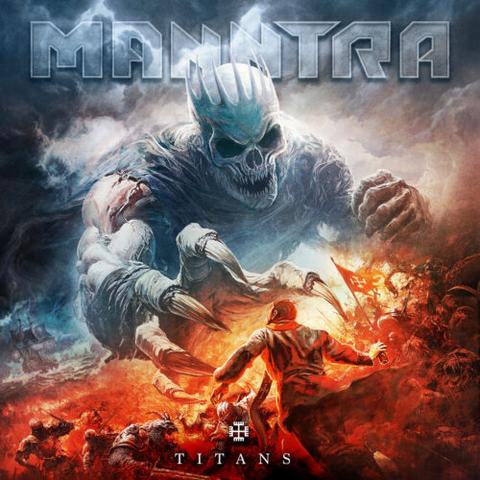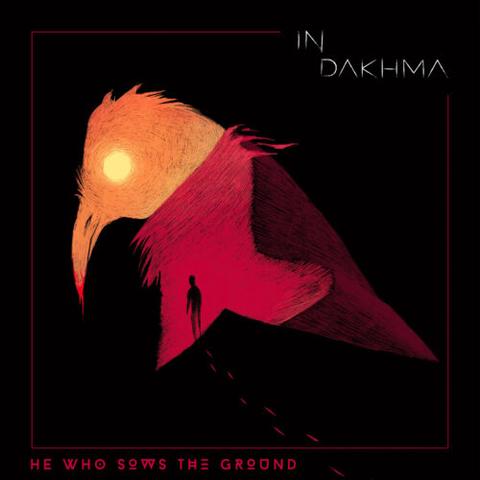AMG’s Unsigned Band Rodeö: Exterior Palnet – Haragma II
By Dolphin Whisperer
“AMG’s Unsigned Band Rodeö” is a time-honored tradition to showcase the most underground of the underground—the unsigned and unpromoted. This collective review treatment continues to exist to unite our writers in boot or bolster of the bands who remind us that, for better or worse, the metal underground exists as an important part of the global metal scene. The Rodeö rides on.”
Another year, another chance for the Rodeö to lasso a lurking but worthy buck. We do dirty business here at Angry Metal Guy and Sons, LLC, sifting promo after promo to catch a whiff of glory. But we do it all for the love of music, a love of exploration, and a love of dealing in the currency of informed and accurate opinions. Just ask the wise and appreciative minds of the powerful minds at Rolling Stone—they agree 12 we’re putting in the time!
But enough about us. You want to hear about Exterior Palnet, right? Don’t worry, they know that the word planet exists. These Croatian oddballs prefer to use a related and wholly untraceable word instead. And in that essence, Haragma II, their sophomore release, follows a musical path of likely patchwork influence and cross-genre reverence. Trv to black metal roots, a frosty trem and low-clack blast persists. Yet in tempo-fluid runs, Exterior Palnet finds a progressive, thrashy, and unpredictable attitude that sets their attack galaxies away from their frosty Norwegian forebears. So buckle up and prepare for extreme forces as you wrestle with the words our Cow Folk have for you today. And, if I’ve timed this right, this is the named debut of ascended n00b Owlswald (formerly 87).3 He’s a hoot. – Dolphin Whisperer
Exterior Palnet // Haragma II [January 24th, 2025]
El Cruevo: Exterior Palnet caused a ruckus in the AMG.com break room. “early Dødheimsgard plus [redacted shit-head black metal]4 wrapped in a [redacted shit-head thrash metal] package!” cried one individual. “[The band] is firing on all cylinders!” another gushed. When I was done cleaning their excrement off the ceilings, I learned that neither was wrong; Haragma II offers an avant-garde take on black metal executed with pummeling leads that sometimes wander into thrashy territory. But neither description clarified the reality that Exterior Palnet evoke the sadly-inactive A Forest of Stars; bolstered with additional pace and power, but weakened by a lack of dynamism and curiosity. Although the music has the sinister, inescapable feel of a spider’s web, it’s simply not very memorable or enjoyable. There are solid riffs, sure. And a warped, beastly attitude. Ordinarily these might fuse into something compelling. But I find myself drifting in and out while listening to Haragma II. For a record playing with such dissonance, heaviness and speed, the fact that it barely holds my attention rings the death knell. Now that my time with it is over, I have no interest whatsoever in returning. 2.0/5.0
Dolphin Whipserer: Yes, it will take more than one listen of Haragma II to settle into its particular brand of dreamy chaos. In a reckless manner, Exterior Palnet scatters crumbs of its mission about with twangy, swaggering groove that belies an incessant rhythmic trickery. Playing its hand first with the blasting and beguiling “Haragma” and “Zaphnath-Paaneah” feels like a sleight in the wake of the grandiose and wailing “Behind the Veil.” But understanding how it’s sudden hi-hat shuffle and endless bending mania can feel both natural and striking is key to unlocking the HII universe. Much like the early blackened scrawl of an early DHG—also informed by the progressive, narrative drama of the classic A Umbra Omega—a tangible mysticism lurks around every barked and battered word that escapes through Tomislav Hrastovec’s mic. Whether it’s the Hebrew prayer recital that closes “Beyond the Veil,” the surrealistic depiction of seasonless erosion of “Exoskeleton,” the elemental chant that guides the conclusion of “Haragma,” a shroud of existential disaster carves HII’s every edge—I’d suggest reading along with its words, which are all fully available on the Bandcamp page.5 The world we live in is bizarre, and Exterior Palnet does their very best to make sense of its senselessness through long dissonant resolves, whiplash pneumatic propulsions, and scraggly Voivodian bass drives. And yet, as “Heracleidae” stumbles to the total journey’s conclusion, a heroic melody casts a light of hope. Anecdotal, densely packed, and passing like the flash of a forgotten moment, Haragma II wears a brand of drama that drills shrill melody against swerving tempos in hopes to find a straight line. For some of us, the search is the answer. 3.5/5.0
Icebreg: Exterior Palnet are a tough nut to crack. Their music is dense and mechanical, rarely giving the listener an aural handhold. At first blush Haragma II presents as an unyielding barrage of dissonance layered on top of polyrhythm, sporting stream-of-consciousness style cavernous vocals. Amidst the scaling, wailing guitars and humming synths rages the beating heart of Exterior Palnet; a drummer6 who’s clearly read the mathcore brief. The undisputed star of this show, stuttering hi-hat rhythms and bursts of tom patterns reminiscent of Thomas Pridgen-era The Mars Volta live alongside monolithic blastbeats and wall-of-sound cymbal crashes. But exemplary performances don’t always translate into approachability, and Haragma II will rebuff all but the most determined musical excavators. Like staring into a Magic Eye puzzle, cycling chord structures and melodies appear in “Haragma” and “Exoskeletons,” but only after patient, focused listens. And while eleven-minute epic “Behind The Veil” revels in its noisy climax and grindy bookend riffs, it weights down the middle of an album that already suffers from potential fatigue issues. A break in the chaos appears in the twilight minutes of “Heracleidae,” and while my ears are thankful for the change in texture, the band’s performance doesn’t seem as tight as the rest of the album, making the section seem more mistake than intention. Exterior Palnet unflinchingly adhere to their style of blackened mathcore,7 and execute it well, but the lack of sonic relief here makes it a tough listen for this reviewer. 2.5/5.0
Alekihnes Gun: The “No Regerts” style named Exterior Palnet have descended from space. One look at the cover is an excellent setup for expectations; with its Voivod by way of Refrigerator Art décor, it’s clear something herky and jerky is on the horizon. Exterior Palnet manage to slide between an assembly of treble heavy riffs and melodies which inevitably walk back into more straightforward pummeling. Album centerpiece “Behind the Veil” is the real test for listener appreciation, clocking in at a whopping eleven minutes and managing to make each minute count with an assembly of moments ranging from mood setting sustained plucking scales to proper tremelos over blast beats. Haragma II doesn’t want for a glut of such moments, though the entirety of the album sounds more like a collection via stream of consciousness more than a series of cohesive songs. This is partially the fault of the mix, where the drums are produced so heavily as to drown out some of the clarity of the riffs on display, and the bass is reduced to an atonal rumble rather than function as support for the chord progressions. There’s a really fun atmosphere on display here and whiffs of excellence to be found across the album, if they can tighten the screws on the song writing a bit and get a mix to serve the overall presentation. 2.5/5
Thyme: Exterior Palnet‘s sophomore album, Haragma II, was slightly off-putting on the first listen, but it’s grown on me like some feral space rash. Riffs pinball in every direction, ranging from chaotically dissonant (“Haragma”) to pensively inquisitive (“Zaphnath-Paaneah”) as if tip-toeing through blackened tulips and sparking like schizophrenic flashbangs, recalling the experimental instrumentality of acts like Krallice, DsO, and early Dødheimsgard. It wasn’t until the twangy swing of “Behind the Veil” kicked in, however, that Exterior Palnet‘s claws really dug in. An eleven-minute odyssey and the album highlight, “Behind the Veil,” displays all the tricks in Exterior Palnet‘s bag. Bruno Čavara’s guitars crash and splash against each other in sprays of dissonant mist as he expertly ushers us across tremolodic waters and rifferous wastelands. With emotionally restless desperation, Tomislav Hrastovec’s tortured shouts and screams pair perfectly with Čavara’s intricate guitars and session bassist Vedran Rao Brlečić’s punchy low-end work. While no drummer was credited, programmed or not,8 the drums sound lush and vibrant, keeping the serpentine instrumentation in check, which is no small feat. My biggest gripe with Haragma II lies in the mix, which I find too loud. I know this is black metal, but there are so many interesting things happening here that I think the mix robs the listener, especially the casual ones, of experiencing the material’s full complexity. Ultimately, Exterior Palnet has released an album worthy of your time, and I hope you check it out. 3.0/5.0
Owlswald: My relationship with black metal is complicated. No longer drawn to the forthright tremolo and low-fi discords of old, I now find the genre’s more avant-garde forms satiating. This leads me to believe Croatia’s Exterior Palnet should be right up my alley, as they deliver a chaotic yet grounded sound that both captivates and overwhelms me in equal measure. Haragma II’s strength lies in its ability to generate a palpable sense of unease and restlessness through swarms of dissonant guitars, anguished cries and shifting tempos. Whether conjuring Deathspell Omega anxiety and agitation through its swirling and undulating soundscape (“Heracleidae”) or transmuting its frenetic energy via taut blasts and fills (“Exoskeletons,” “Zaphnath-Paaneah”), Haragama II is all about keeping the listener off-kilter. Despite its often exhausting intensity, Exterior Palnet offers brief but welcome respites, including the Doldrum-esque groovy syncopations within “Haragma” or the unexpected shoegaze-tinged textures ending “Behind the Veil.” Still, Haragma II’s songwriting would benefit from greater balance, as it currently prioritizes pandemonium through a loud, upfront mix. Exterior Palnet reach their peak when atmosphere, groove and prevailing intensity are in equilibrium. Haragma II proves there is still room for growth. Good.
#2025 #AForestOfStars #AngryMetalGuySUnsignedBandRodeo #AngryMetalGuySUnsignedBandRodeo2025 #BlackMetal #CroatianMetal #Dödheimsgard #Doldrum #ExteriorPalnet #HaragmaII #IndependentRelease #Jan25 #Krallice #ProgressiveBlackMetal #Review #Reviews #SelfRelease #TheMarsVolta #Voivod






